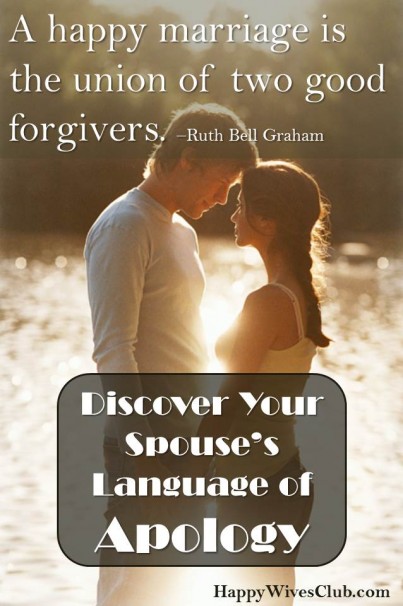Discover Your Spouse’s Language of Apology
When I read this post by our fabulous HWC contributor, Lori Ferguson, the first thing I thought was, “Wow!”
For me, the language of apology is a brand new discovery. If the concept is new to you as well, I promise, you are in for a real treat today.
Until tomorrow…make it a great day!
___________
Do you ever “mess up”? Do you make mistakes – get it wrong – react without thinking – jump to conclusions – overreact – explode – forget or behave thoughtlessly?
Yup. Me too.
What do you do when saying “I’m sorry” isn’t enough?
I imagine we all find ourselves in that spot where we need to apologize for various issues in life. Marriage may be filled with joy and laughter, fun and exhilaration, peace and rest, but it can also be sprinkled with hurt, misunderstandings, disappointments and angst.
It’s important to know how to apologize.
Some people are great with an apology. They’re able to put a smile back on their spouse’s face with little to no effort. Other couples don’t fair quite as well.
These couples might even avoid saying I’m sorry to their spouse because they think the next step is either frozen silence or a white-hot blast of words listing all past issues.
What’s missing?
Maybe you need to learn your spouse’s language of apology?
Why isn’t just saying you’re sorry enough? Our parents always made us say “I’m sorry” when we did something wrong, even if we weren’t sorry at all. What else needs to be said – or done?
Dr. Gary Chapman and Jennifer Thomas worked for more than two years researching why most apologies aren’t effective. (You might know Gary Chapman from his book “The Five Love Languages“.)
A few months ago I had the privilege of spending an evening with Jennifer Thomas talking about the book that grew from their research. The finished product is called “The Five Languages of Apology”, released in 2008, and then a re-write of the book this year with a new title, “When Sorry isn’t Enough.”
What are the 5 Languages of Apology?
While a person would probably respond best to one type of apology over another – because, after research Chapman & Thomas learned we all have a primary Apology Language – hearing more than one is also helpful. Here’s an overview of the 5 ways to express apology:
- Expressing regret – “I am sorry.”
- Accepting responsibility – “I was wrong.”
- Making restitution – “What can I do to make it right?”
- Genuinely Repenting – “I’ll try not to do that again.”
- Requesting forgiveness – “Will you please forgive me?”
So how do you know which “language” you or your husband needs to hear?
First, of course, I’d recommend reading the book. But until you can purchase it, there’s a nifty online 20-question assessment that will open your eyes to new ways to say “I’m sorry”. After doing the assessment you’ll receive a detailed explanation to help you understand the results.
Both Robert, my husband, and I took the assessment. It was insightful. My primary language of apology was to Genuinely Repent. I need to hear that when Robert messes up, he will try in every way possible, and in new ways, not to repeat what he’s done. His primary language of apology was Expressing Regret – for me to let him know I truly feel sorry for causing him pain, and take responsibility.
A Step Further
In addition to the conceptual, this assessment adds in suggestions. For example – within the explanation of using Robert’s Language of apology (Expressing Regret) is the suggestion of to best communicate:
“The “Expressing Regret” Apology Language speaks most clearly when the person offering the apology reflects sincerity not only verbally, but also through body language. Unflinching eye contact and a gentle, but firm touch are two ways that body language can underscore sincerity.”
I love practical suggestions.
What about you?
Taking this assessment has provided a real source of conversation for Robert and me – we weren’t fully one “language” – we had scores that included a few of the other Apology Languages. Interestingly, my score had a “0″ for Robert’s primary apology language. And he had a low score for my primary apology language. So when I express how sorry I am for messing up, I will rarely just express regret – I’m more likely to give reasons and solutions for how I won’t do it again. I might miss letting him know how deeply I feel, because I’m busy expressing “I’m sorry” in my own way.
I encourage you to try the assessment – and invite your spouse to do the same!
##
JOIN THE 1,000,000 MEMBER CHALLENGE: If you haven’t already done it, what are you waiting for? Join the club! It takes only a few seconds and, of course, is free.
MARRIAGE MONDAYS Link Up Party: Bloggers, join us here every third Monday of the month for our fabulous link-up party! Join us August 19th for our next Marriage Mondays!




